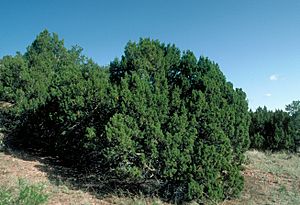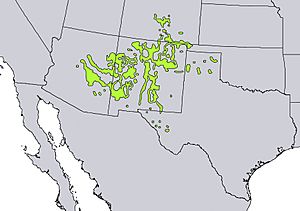Juniperus monosperma facts for kids
Quick facts for kids Juniperus monosperma |
|
|---|---|
 |
|
| Conservation status | |
| Scientific classification | |
| Genus: |
Juniperus
|
| Species: |
monosperma
|
 |
|
| Natural range | |
The One-seed Juniper (scientific name: Juniperus monosperma) is a type of juniper tree. It grows naturally in western North America. You can find it in the United States in states like Arizona, New Mexico, southern Colorado, western Oklahoma, and western Texas. It also grows in the very northern part of Chihuahua, Mexico. These trees usually grow in places that are 970 to 2300 meters (about 3,180 to 7,550 feet) above sea level.
This juniper is an evergreen coniferous shrub or a small tree. This means it keeps its leaves all year round. It typically grows to be 2 to 7 meters (about 6 to 23 feet) tall, but sometimes it can reach 12 meters (about 39 feet). It often has many stems and a thick, round top. The bark is gray-brown and peels off in long, thin strips, showing a bright orange-brown color underneath.
The leaves of the One-seed Juniper are small and flat, like scales. They are about 1 to 2 millimeters long. On young plants, the leaves look more like needles. The cones are soft and look like berries. They are dark blue with a pale blue-white waxy coating. Each cone usually holds just one seed, which is why it's called the "One-seed" Juniper. These cones take about 6 to 8 months to ripen. Birds and other animals love to eat them.
Most One-seed Juniper trees are either male or female. This means male cones (which produce pollen) and female cones (which produce seeds) grow on separate trees. However, sometimes you can find a tree that has both male and female cones. This tree is known for having very deep roots. Its roots can go as far as 61 meters (about 200 feet) underground! This makes it one of the plants with the deepest roots in the world.
Sometimes, you might see cones where the seed is showing. People used to think these were from a different type of juniper. But now we know that this happens when insects damage the cones as they are growing. The seeds from these damaged cones usually cannot grow into new plants.
There is a similar type of juniper called Juniperus angosturana. It was once thought to be a different kind of One-seed Juniper. It looks very much like the One-seed Juniper but has slightly thinner shoots.
Other common names for this tree are single-seed juniper and cherrystone juniper.
Contents
Animals That Use One-seed Juniper
Many animals enjoy the berry-like cones of the One-seed Juniper.
- Hopi chipmunks
- Quail
- Foxes
- Rock squirrels
- Deer
Goats in New Mexico also eat the leaves of this tree.
How People Use One-seed Juniper
Historically, different Native American tribes used the One-seed Juniper in many ways.
The Navajo tribe ate the ripe cones in the fall or winter. They also made a dye from the bark and cones. The wood was used for many different things.
Zuni People
The Zuni people used the roots of the One-seed Juniper. They would chew the root and apply it to newborn babies to help them grow strong. They also used the leaves to make a special drink for muscle aches. The wood was a favorite for fires, especially for ceremonies. The shredded, stringy bark was used as tinder to start fires with fire sticks for the New Year celebration.
See also
 In Spanish: Juniperus monosperma para niños
In Spanish: Juniperus monosperma para niños


